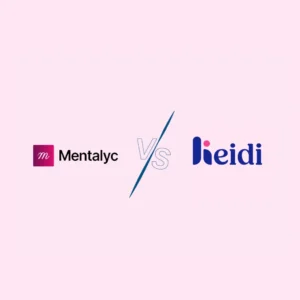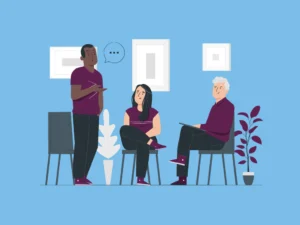Imagine entering your office and discovering a voicemail from a prospective client eager to schedule an initial session with you! This client heard about your therapy practice from a friend and is ready to dive in. But wait, they are concerned about leaving personal details on a recording. As therapists, our voicemails are often the first impression we make, and making them count is vital! A warm message can make all the difference in showing your clients that you value their time and privacy.
In this article, you will learn how to create an engaging voicemail script that is HIPAA-compliant and welcoming to potential clients. You will discover the best practices for the tone of the message, the information to request, details to include in case of a crisis, ways to showcase your personality, and how to provide anticipated callback timeframes.
Also, the article will offer examples and templates made for solo and group practices. You can build a strong rapport and trust from the first call with a thoughtful, caring voicemail. Get ready to impress your clients and grow your practice with these easy-to-implement tips and techniques!
The Benefits of Recording a Personal Voicemail Greeting
Creating a personalized voicemail greeting for your practice has several advantages. Firstly, it enables you to connect with callers more personally. Hearing your actual voice helps establish a personal connection and builds trust before the caller even speaks with you. Your tone of voice and word choice also convey tenderness and competence, creating a positive impression on the caller.
Professionalism
Crafting a well-thought-out voicemail greeting can significantly affect how you come across to your callers. It can help you project an image of professionalism and efficiency, demonstrating your commitment to providing the best possible experience for your existing and potential clients. Personalizing your greeting can further enhance your professionalism and underscore the value you place on your callers. You can set yourself apart from the competition by showing that you pay attention to details and are committed to providing exceptional service.
Reduces Confusion
Crafting a clear and concise voicemail greeting can help avoid confusion for callers. It is essential to include all vital information in your message, such as your name, credentials, area of expertise, and instructions for leaving a message. By doing so, you can ensure that callers leave complete messages without needing to call back repeatedly.
Sets Proper Expectations
Your voicemail greeting is essential for communicating with callers about when to expect you to return their calls and what information you need to assist them. This helps prevent missed opportunities and caller frustration.
Essential Factors to Consider Before Recording Your Voicemail Greeting
Crafting a voicemail script that aligns with your unique style and meets the needs of your practice is crucial for establishing a solid client connection. Consider your goals and priorities as a therapist to create a compelling and thoughtful voicemail script. Identify why you want to record a personal greeting and what you hope to accomplish. Once you have a clear idea of your objectives, you can craft your message with these goals in mind.
To provide exceptional customer service and build trust with your clients, it's essential to keep your message concise and engaging. A brief and to-the-point voicemail message will help your callers feel confident and at ease, knowing they will receive the necessary assistance. Therefore, keeping your voicemail message to around 15-30 seconds is recommended. More extended greetings can become tedious for callers.
Creating a personalized and thoughtful voicemail script can make a positive first impression and set the stage for a productive therapeutic relationship.
The General Rules of Thumb: Writing an Effective Therapist Voicemail Script
To create a compelling voicemail that reflects your professionalism and approachability, use the following best practices:
Keep it Personal
When recording a greeting message, avoid using a generic greeting. Instead, record a personalized message that reflects your personality. It will help you connect with your clients better. While recording, provide your full name, credentials, and title. Also, spell out any acronyms that you use. Briefly describe your clinical focus and specialties. For instance, you can say, "I am a licensed clinical social worker specializing in trauma therapy and cognitive behavioral techniques." Use a welcoming and empathetic tone to convey warmth, care, and understanding.
Share Your Availability
It's always helpful to inform your callers about your working hours and the expected time for a callback. This ensures they know when to expect a response and avoids confusion or frustration. You can say something like, "I check my messages regularly on weekdays (Monday through Friday) during business hours, and I aim to return calls within 24 hours." Acknowledging your callers' needs and concerns can make a big difference in building trust and setting expectations. Additionally, show empathy by saying, "I understand you may be having a difficult time. Please know I will respond to your call as soon as possible." This lets your caller know that you care and are ready to help.
Ask for Necessary Information
When dealing with new clients, gathering all the necessary information from them is important. Asking for their complete name, phone number, and a brief message explaining the reason for their call can help you respond to their needs more efficiently. It is also crucial to guarantee privacy to make the caller feel comfortable sharing their information. A polite reminder such as "Any information you share will be kept strictly confidential" can help establish trust and build a positive relationship with the caller.
Crisis Instructions
If you receive a call related to an emergency situation, it is essential to advise the caller to contact emergency services or a crisis hotline for immediate help. You may use the following message: "If you are experiencing a mental health emergency, please call 911 or the National Suicide Prevention Lifeline at [number here]". This will ensure that callers in crisis receive the urgent support they need.
Keep Your Script Up to Date
Reviewing and updating your voicemail greeting from time to time is necessary to ensure that the information provided is current and accurate. You can update your contact details, hours of availability, or any other relevant information to provide the best experience for your clients and their loved ones. A personal and informative voicemail greeting is a simple way to create a positive first impression!
Record Multiple Versions
Consider recording separate greetings for new clients, existing clients, and referrals. This allows you to personalize the experience for each caller type. You can also record different greetings for holidays and weekends to show that you offer year-round support.
Test and Revise Frequently
After recording your voicemail greeting, test it by leaving yourself a message from another phone. Listen to how it sounds from a caller's perspective and make any necessary changes to improve clarity, tone, and the information you provide. Then, continue testing and revising your script every few months to maintain its effectiveness.
Add Some Humor if Appropriate
You can lightly incorporate humor into your greeting if your natural style includes humor. However, avoid jokes that may appear inappropriate or unprofessional for your practice. The key is to sound approachable while still conveying your competence and professionalism.
Effective Voicemail Scripts for Solo Practitioners
As a solo therapist, your voicemail greeting should convey a friendly, intimate tone while providing key information for clients and callers.
Here are some examples to get you started:
Script Option 1:
"Thank you so much for contacting [Practice Name]. My name is [Your Name], and I am the therapist here. I'm so sorry I was unable to answer your call right away. Please know that I'm here to help you in any way I can. Please leave a message with your name, phone number, and a brief description of your situation; I'll be sure to get back to you within 24 hours. And if you can let me know the best time to reach you, that would be helpful. If you're experiencing an emergency, please don't hesitate to dial 911 or visit your nearest emergency room for immediate assistance. Thank you again for reaching out, and I hope to speak with you soon."
Script Option 2:
"Hello, thank you for calling [Practice name]. This is [Your name]. I'm sorry I can't answer your call right now, but I want to assure you that I will do my best to get back to you within 24 hours. To help me better understand your situation, please leave your full name, phone number, and a brief message about what's on your mind. I look forward to hearing from you and helping you in any way I can. In case of an emergency, please dial 911 immediately."
Example Voicemail Greetings for Group Mental Health Practices
To ensure your group practice sounds professional and organized, crafting a voicemail greeting with some vital components is paramount. These elements comprise your name, extension number, a clear description of your services (if they vary from your colleagues), and identifying who the caller can expect a call back from if multiple therapists are in your practice. Alternatively, informing the caller of this is crucial if an intake coordinator handles the administrative work for new clients. This will guarantee the caller knows who to anticipate hearing back from and where to direct any follow-up calls or inquiries.
Here are some sample scripts to assist you in creating an effective voicemail greeting for a group practice:
Script Option 1:
"Thank you for reaching out to [Practice Name]. My name is [Your name], and I am the [Your position]. We understand your call is important, but we cannot answer now. Please leave your name, number, and a brief message, and we will do our best to return your call within 24 hours. We apologize for any inconvenience this may cause. If you have an emergency, please call 911 or proceed to the nearest emergency room. Your safety is our top priority."
Script Option 2:
"Thank you for reaching out to [Practice Name]. We are sorry we missed your call. We understand that seeking help can be difficult, and we appreciate your courage in contacting us. Please leave your name, number, and who you are trying to reach – Dr. Smith, Jane Doe LCSW, or our intake coordinator, John. We assure you that the appropriate person will return your call within one business day. If you have an urgent matter, please call emergency services. We are here to support you through your journey to mental wellness."
Ensuring a HIPAA-Compliant Voicemail Script
Voicemail scripts also include knowing what to say when leaving voicemail messages for clients. Complying with HIPAA guidelines to protect clients' privacy and confidential information is crucial, as these guidelines can help safeguard sensitive health information and prevent potential breaches. Taking certain precautions when leaving voicemail messages can maintain a professional and trustworthy relationship with your clients while securing their confidential information.
Some key things to keep in mind when leaving a voicemail on a client's phone:
1. Avoid using client-identifying information such as names, dates of birth, social security numbers, diagnoses, or treatments. Focus only on scheduling or following up, and refer to clients in general terms only. 2. 3. Refer to your practice in general terms and avoid giving specific details about appointments or locations in your voicemail. 4. 5. Forgo mentioning appointment times, dates, or locations in your voicemail script. 6. 7. When indicating your unavailability, mention that you are "out of the office" or "unavailable" instead of specifying the reason. 8. 9. Do not leave voicemails with sensitive information for family members or other third parties without the client's consent. 10.
Conclusion
Crafting a well-written and thoughtful voicemail script may seem minor, but it can significantly impact your private practice. By creating a caring and informative message that reflects your professionalism and sets accurate expectations, you can establish a stronger connection with potential clients and make a great first impression on anyone who calls your office. Remember, every caller deserves a helpful experience, and you have the power to provide it by creating a well-crafted voicemail greeting. The power of a personalized message can be the first step towards building a thriving practice that truly makes a difference in people's lives.
If you want to take your private practice to new heights, optimize your progress notes, and enhance your overall performance, you can use Mentalyc's free trial. This is an excellent opportunity to explore new possibilities and improve your skills, so don't hesitate to sign up and see what Mentalyc can do for you.
FAQs: How to Write a Voicemail Script for Mental Health Professionals
How do I record my voicemail greeting?
Most phone systems can record a personalized message that greets callers and provides information when you cannot answer the phone. You can check your phone system manual for specific instructions on recording a greeting. Generally, you can access your voicemail box, select the option to record a greeting, speak your message, and save the recording. It is crucial to speak clearly and at an even pace to communicate your message effectively.
What should I include in my voicemail script?
Your voicemail message should include the following details:
Your name and the name of your practice.
Your availability and when callers can expect a return call.
The information you need the caller to leave, such as their name, phone number, and a brief message about the reason for their call.
Instructions for crises, such as "If this is an emergency, please call 911 or go to your nearest emergency room."
A friendly and professional tone that matches your therapy practice.
Make sure your message is clear and concise so callers can leave you a message quickly and confidently.
How often should I update my voicemail greeting?
Ideally, you should review and update your voicemail greeting every three months or whenever your schedule or availability changes. It's essential to update your message when you're going on leave, your office hours change or your practice relocates. An outdated voicemail greeting can create a negative impression of your practice and confuse callers.
Should I personalize my voicemail greeting for solo vs. group practices?
When greeting clients, it's important to tailor your script to whether you have a solo or group practice. For a solo practice, giving clients a more personal greeting that includes your name and the type of therapy you offer is appropriate. On the other hand, for a group practice, it's better to provide clients with a more general greeting that mentions the name of the practice and the types of therapists or services available. Regardless of your practice type, ensure your greeting sounds professional, friendly, and helpful.
What's the ideal length for a voicemail greeting?
When recording your voicemail greeting, it's essential to keep it brief yet informative. Keep it within 30-45 seconds, and speak clearly, avoiding long pauses and the need to repeat crucial information. Your greeting should focus on the details that callers need to know and be delivered in a kind and thoughtful tone.
Resources:
Gonter, S. (2019, July 17). Voicemail Script For Your Mental Health Or Wellness Private Practice. b.mindful Louisville. https://www.bmindfullouisville.com/practice-building-blog-1/2019/7/10/voicemail-script-for-your-mental-health-or-wellness-private-practice
LoFrisco, B. (2018, March 13). Voicemail Greetings. MastersInCounseling.org. https://mastersincounseling.org/counseling/voicemail-greetings/
Travis, J. (2022, October 19). Voicemail For Therapists: 6 Ways to Improve Your Message and Hang On To That Client. Grow Your Jane Private Practice. https://www.janetravis.co.uk/voicemail-for-therapists/
Voicemail First Impressions. (2010, May 7). Psychology Today. https://www.psychologytoday.com/us/blog/you-say-more-than-you-think/201005/voicemail-first-impressions
Why other mental health professionals love Mentalyc

“If I were recommending this software to a colleague, I would tell them that it is the best thing that they could do for their practice.”
Licensed Professional Counselor

“Do yourself a favor, make your life easier. Use the tools that are readily available … I found Mentalyc to be one of the best tools that I’ve ever used.”
Licensed Marriage and Family Therapist

“For those who have hesitations … It is a lifesaver. It will change your life and you have more time to be present with your patients.”
Licensed Clinical Social Worker

“It immediately changed my quality of life, personally and professionally. I went from 3–4 hours a week of notes to 1 hour at most … that alone is invaluable personally and professionally.”
Owner/Independently Licensed Marriage & Family Therapist (IMFT)






